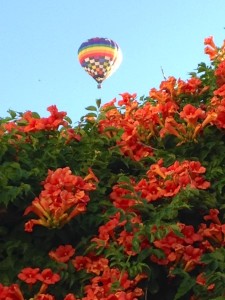Choosing right vines can enhance ‘vertical’ gardening experience

Although many have expressed the sentiment that planting a tree means believing in the future, many also do not have the patience to wait for that vertical addition to stretch its lofty presence high above the garden floor.
As part of the instant gratification population pervasive in our society, I have found vertical gardening in the high desert is much more effective and water-wise by choosing vines that thrive in our growing zone. Vines give “green” interest to my walled garden and provide plenty of shade when given the appropriate structure on which to climb.
The garden for me is actually an outdoor laboratory in which I can explore plant species characteristics in a relatively controlled environment while decorating the space for my own visual pleasure. Vines assist me in that endeavor and relatively quickly as they will cover the desired garden structure or wall in only a few growing seasons, which in our area are relatively long as compared to more northerly climes.
The four pillars of the pergola are great supports for the vines I chose for observing which will grow best in this environment. I deliberately planted next to three pillars, avoiding the southwest corner as plants grow toward the afternoon sun. The southeast corner received a trumpet vine; the northeast has a Queen Elizabeth climbing rose; and after several failures including a wisteria, the northwest corner is graced by a honeysuckle which is thriving in its designated space.
As anticipated, the trumpet vine dominates the top of the pergola and, after 10 growing seasons, provides day-long dense shade for my outdoor dining area.
All three vines provide beautiful floral displays from late spring through late fall. Two scent the air with their heady fragrance, furthering the enjoyment of my outdoor room.
Other parts of my garden have vines to elevate the level of visual enjoyment as well. The block retaining wall that defines the property line on one side of the yard is fully covered in green by a single Boston ivy. It is the only species I have planted that attaches to the wall with adhesive pads on its tendrils.
The Carolina Jessamine greets me in early spring with yellow buttercup-like flowers and is grown on trellises against an expanse of the northeast side of my house. It is designated as USDA zone 8, but it is planted in an microclimate, remaining evergreen all winter.
The sweet autumn clematis, which requires shaded roots and sun-drenched foliage, climbs on a series of trellises by twining. In late summer, it displays a multitude of tiny white scented flowers.
Finally, late last season I introduced two chocolate vines onto trellises that border my property in different locations. They are the new experiment in vining plants. The few mid-spring flowers were small deep purplish bronze with a scent that will increase as the plant matures and produces more flowers.
A garden is truly never static. With each season, the vines provide more beauty and enrich the ecosystem of which they are now a grand part. Birds, bees, butterflies and other interesting insects find many hours of interaction with these vertical garden plants.
I, too, find myself luxuriating in their shade while treasuring their beautiful floral displays. Vines may truly be my favorite part of this outdoor laboratory.
This article text was previously published in the Rio Rancho Observer.

